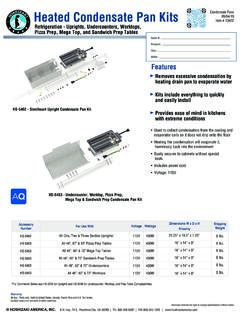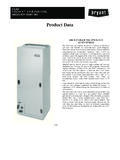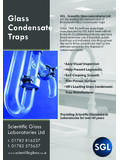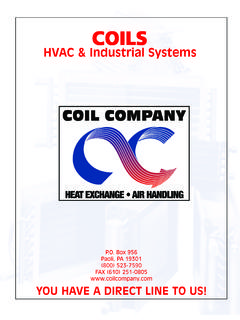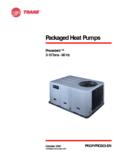Transcription of Evaporator Coil Cleaning and Condensate Drain Maintenance ...
1 American Standard 2007 1 Service Guide Evaporator Coil Cleaning and Condensate Drain Maintenance Guidelines ORDER No: UN-SVG001A-EN DATE: October 9, 2007 Introduction This document defines American Standard and Trane s recommendations for Cleaning and maintaining Evaporator coils and Condensate lines in American Stan-dard and Trane Residential Air-handlers, Furnace Coils and Packaged units.
2 The intent of this paper is not to endorse any particular Cleaning products. The use of product names is only to provide clarification for the service person of the pH of some products. The Technician performing the service or Maintenance is required to read the Material Safety Data Sheet (MSDS) for all coil- Cleaning products. The Service Technician is required to identify not only an individual product s pH; the Service Technician should also have a complete understanding of all safety and handling instructions for each Cleaning product used and the air conditioning equip-ment.
3 WARNING Hazardous Service Procedures! The Maintenance and troubleshooting procedures recommended in this guide could result in exposure to electrical, mechanical or other poten-tial safety hazards. Always refer to the safety warnings provided throughout this guide concerning these procedures. When possible, dis-connect all electrical power including remote disconnect and discharge all energy storing devices such as capacitors before servicing. Follow proper lockout/tagout procedures to ensure the power can not be inad-vertently energized.
4 When necessary to work with live electrical compo-nents, have a qualified licensed electrician or other individual who has been trained in handling live electrical components perform these tasks. Failure to follow all of the recommended safety warnings provided, could result in death or serious injury. NOTICE: Warnings and Cautions appear at appropriate sections throughout this bulletin. Read these carefully. WARNING Indicates a potentially hazardous situation which, if not avoided, could result in death or serious injury. CAUTION Indicates a potentially hazardous situation which, if not avoided, may result in minor or moderate injury.
5 It may also be used to alert against unsafe practices. CAUTION Indicates a situation that may result in equipment or property-damage-only accidents. UN-SVG001A-EN 2 Discussion Coil and Cabinet Cleaning 1. American Standard s and Trane s recommendation for coil Cleaning is to use neutral-pH cleaners. This is required to avoid the use of strong acids and strong base clean-ers. Thus, cleaners with pH range from 5 to 11 are suitable for coil Cleaning .
6 This range includes such over-the-counter cleaners as Simple Green All Purpose Cleaner, or HVAC coil cleaners like Nu-Calgon Evap Pow'r . 2. Strong acidic cleaners (pH of 5 or less) that contain hydrochloric, sulfuric, nitric, or acetic acid are not recommended for use on copper-tube, aluminum fin coils or on aluminum tube, aluminum fin coils. Presence of these acids will result in rapid corro-sion of the metals. 3. Strong alkali (base) cleaners (pH of 11 or more) containing sodium, potassium, or ammonium hydroxide are not recommended as they will aggressively corrode alumi-num tubes and fins.
7 Strong ammonium hydroxide cleaners will also cause stress cor-rosion cracking of copper tubes. 4. American Standard and Trane recommend completely rinsing all cleaner from the coil - including cleaners identified as No-Rinse cleaners. Residual cleaners may decom-pose over time producing low molecular weigh, organic acids that lead to formicary corrosion. 5. We agree with many of our dealers that only removing an Evaporator coil is the best way to effectively clean a coil that is heavily contaminated. This is accomplished by removing it from the cabinet and using a strong water stream such as from a garden hose.
8 Lightly spraying cleaners on a coil with a spray bottle and rinsing with water from a spray bottle does not effectively clean it and certainly does not effectively rinse the cleaner from the coil. 6. A coil operating for many months without an air filter will likely require removal to achieve proper Cleaning . Visual inspection of the indoor equipment is the ideal deter-mining factor if a coil is contaminated enough to warrant coil removal for Cleaning . Evi-dence of this would be a heavy mat of fiber and hair on the inlet side of the coil and discoloration of the fins on both sides of the coil.
9 Another, easily detectable symptom is a dirty blower wheel. A dirty blower wheel indicates a need for coil inspection as this means contaminants have been getting past the filter at some time or the unit has been operated without a filter. Air handler or Packaged Unit: Remove the Evaporator coil and fan assembly for proper Cleaning if there is also contamination on the inside of the cabinet and/or contamination other than normal household dirt, lint (etc.) on the coil. Proper clean-ing of the cabinet insulation, wiring, and other components are required as well.
10 Wipe these surfaces down with the same neutral or moderate pH cleaners de-scribed in item number 1 above Cased Coil: Remove the Evaporator coil for proper Cleaning if there is also contami-nation on the inside of the cabinet and/or contamination other than normal house-hold dirt, lint (etc.) on the coil. Proper Cleaning of the cabinet insulation and other components are required as well. Wipe these surfaces down with the same neutral or moderate pH cleaners described in item number 1 above. If the coil is to be removed we require adherence to all safety warnings and cautions that appear in the literature shipped with the equipment and affixed to the units itself.

